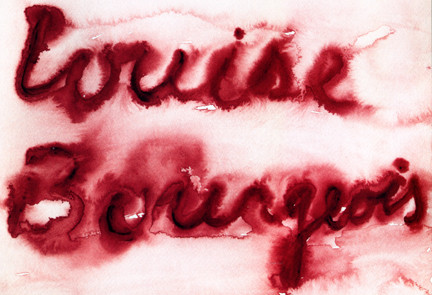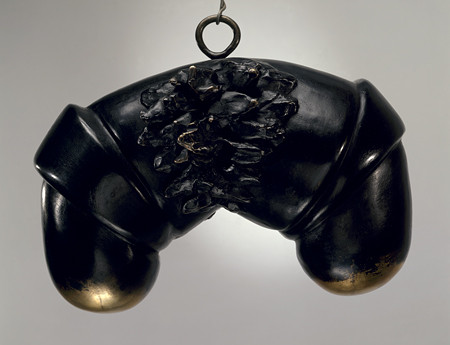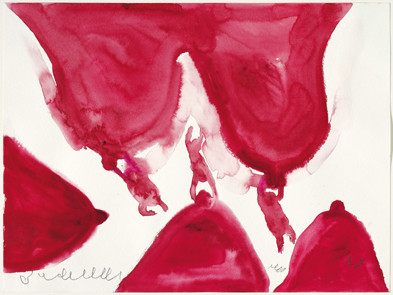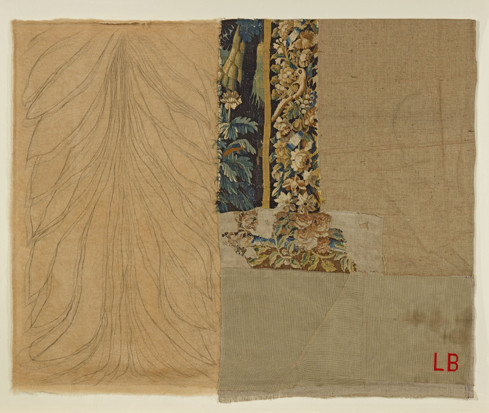Louise Bourgeois: A Stretch Of Time. 40 Jahre Karsten Greve Köln
04 Sep - 12 Dec 2009
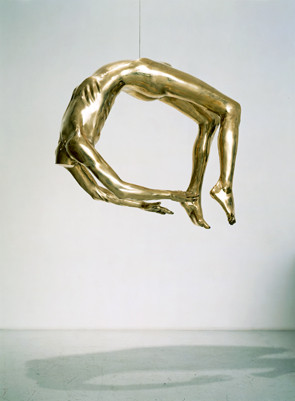
Louise Bourgeois: Arch of Hysteria, 1993, hanging sculpture, patinated and polished bronze, 33 x 40 x 23 ins
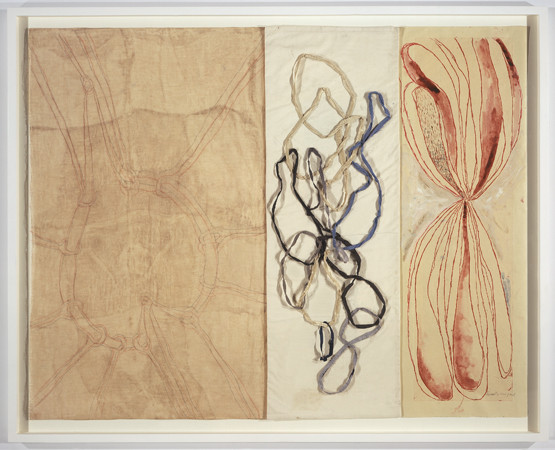
Louise Bourgeois: A Stretch of Time, 2007, mixed media on paper and fabric, triptych, 59 1/2 x 71 1⁄4 ins
Karsten Greve Gallery is very pleased to announce its upcoming exhibition dedicated to Louise Bourgeois. The comprehensive solo exhibition is shown on occasion of the season start of the Düsseldorf and Cologne galleries.
With a special focus on hanging works, masterpieces from the period of 1964 until 2009 are on view in this retrospective exhibition. Therefore it gains a quality and direction never seen in Germany before.
Continuous works of the almost 98-year old artist’s oeuvre are hanging pieces. Similar to a wild range of Bourgeois` works the determinant of these works-groups are impressions of her childhood. Her principal themes are the basic questions of human life, such as birth and death, love and hate, the human body and sexuality. This creative process allows Bourgeois to come to terms with her past and herself. Of particular importance for Bourgeois is the state of ambivalence that is expressed by the hanging objects: “Horizontality is a desire to give up, to sleep. Verticality is an attempt to escape. Hanging and floating are states of ambivalence”.
In the year 1968, as one of the early hanging works, the Janus series was produced. Named after the Roman divinity Ianus – traditional ambivalent, forward- and backward looking allegorised – Bourgeois created different versions of those anatomically ambiguous objects; Janus, Janus in Leather, Janus Fleuri. Hanging at the viewers’ eye level, the presentation of the bronzes allows them to swing and spin around, but through the strength of its gravity the objects are at the same time restricted. For Bourgeois this instability expresses doubt, ambiguity and hesitancy – a hesitancy to pursue a particular path.
The group of works Arch of Hysteria is based on Bourgeois interests on Jean-Martin Charcot, a French neurologist of the 19th century. Charcot researches the course of hysteria, which has been related to the reproductive system of women. Inspired by the causal connection between physique and psyche, Bourgeois` Arch of Hysteria is a complex melding of physical, emotional and psychical conditions. A work which is not confined to the one or the other gender. Arch of Hysteria is a bronze casting with a golden and polished surface. It shows a naked, male and headless body. It is hanged up at its navel, which symbolizes the centre of someone’s body and the native connection to someone’s mother. It seems to hover in a state torn between extension and relaxation. In the reception of the viewer it is quite vague if the curved figure suffers pain or is in ecstasy. The fact that the figure has no head increases the separation of inside and outside; so to say between mind and body.
In the 1990s the artist began to bring her own clothes and fabrics in her work. As Bourgeois` family had a restoration workshop for ancient textiles, this development can be psychologically ascribed to Bourgeois identification with her mother. The work of combining and sewing drapery together puts herself in the place of her mother, who worked as a weaver. By this she overcome her fear to grow lonely or to get abandoned.
Louise Bourgeois lives and works in New York City. Her work was recently dignified with a comprehensive retrospective, which was for the first time exhibited in 2007 at the Tate Gallery in London and travelled afterwards to Centre Pompidou in Paris, to Guggenheim in New York, to MoCA in Los Angeles and to the Hirshorn Museum in Washington.
On occasion of this exhibition a catalogue (English/German/French) with a text by Robert Storr will be published.
For further information or requests regarding photographic material please contact
Celia Fanselow at: galerie.greve@tonline.de
With a special focus on hanging works, masterpieces from the period of 1964 until 2009 are on view in this retrospective exhibition. Therefore it gains a quality and direction never seen in Germany before.
Continuous works of the almost 98-year old artist’s oeuvre are hanging pieces. Similar to a wild range of Bourgeois` works the determinant of these works-groups are impressions of her childhood. Her principal themes are the basic questions of human life, such as birth and death, love and hate, the human body and sexuality. This creative process allows Bourgeois to come to terms with her past and herself. Of particular importance for Bourgeois is the state of ambivalence that is expressed by the hanging objects: “Horizontality is a desire to give up, to sleep. Verticality is an attempt to escape. Hanging and floating are states of ambivalence”.
In the year 1968, as one of the early hanging works, the Janus series was produced. Named after the Roman divinity Ianus – traditional ambivalent, forward- and backward looking allegorised – Bourgeois created different versions of those anatomically ambiguous objects; Janus, Janus in Leather, Janus Fleuri. Hanging at the viewers’ eye level, the presentation of the bronzes allows them to swing and spin around, but through the strength of its gravity the objects are at the same time restricted. For Bourgeois this instability expresses doubt, ambiguity and hesitancy – a hesitancy to pursue a particular path.
The group of works Arch of Hysteria is based on Bourgeois interests on Jean-Martin Charcot, a French neurologist of the 19th century. Charcot researches the course of hysteria, which has been related to the reproductive system of women. Inspired by the causal connection between physique and psyche, Bourgeois` Arch of Hysteria is a complex melding of physical, emotional and psychical conditions. A work which is not confined to the one or the other gender. Arch of Hysteria is a bronze casting with a golden and polished surface. It shows a naked, male and headless body. It is hanged up at its navel, which symbolizes the centre of someone’s body and the native connection to someone’s mother. It seems to hover in a state torn between extension and relaxation. In the reception of the viewer it is quite vague if the curved figure suffers pain or is in ecstasy. The fact that the figure has no head increases the separation of inside and outside; so to say between mind and body.
In the 1990s the artist began to bring her own clothes and fabrics in her work. As Bourgeois` family had a restoration workshop for ancient textiles, this development can be psychologically ascribed to Bourgeois identification with her mother. The work of combining and sewing drapery together puts herself in the place of her mother, who worked as a weaver. By this she overcome her fear to grow lonely or to get abandoned.
Louise Bourgeois lives and works in New York City. Her work was recently dignified with a comprehensive retrospective, which was for the first time exhibited in 2007 at the Tate Gallery in London and travelled afterwards to Centre Pompidou in Paris, to Guggenheim in New York, to MoCA in Los Angeles and to the Hirshorn Museum in Washington.
On occasion of this exhibition a catalogue (English/German/French) with a text by Robert Storr will be published.
For further information or requests regarding photographic material please contact
Celia Fanselow at: galerie.greve@tonline.de

